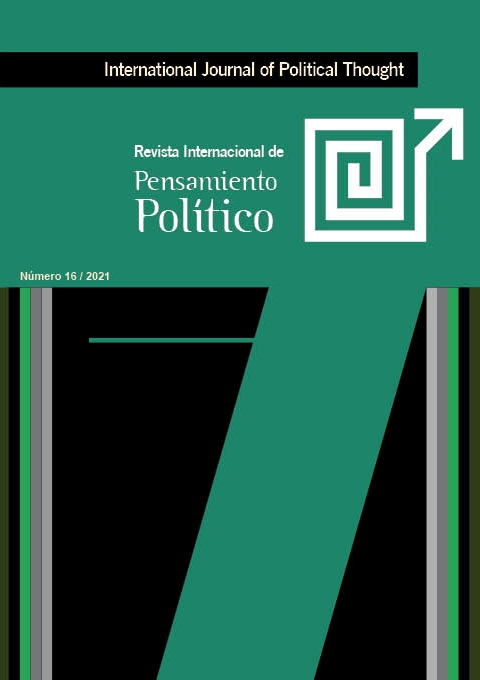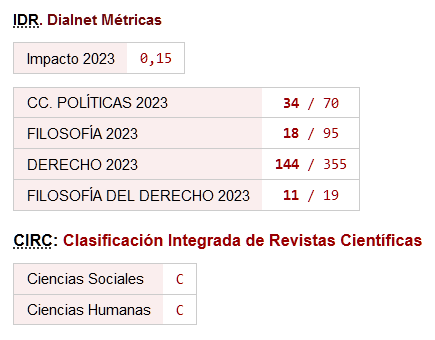Misoginia estética en el «Art Nouveau». El miedo a la mujer nueva en la sociedad de «Fin-de-Siglo»: de la Salomé de Huysmans a la Lulú de Wedekind
DOI:
https://doi.org/10.46661/revintpensampolit.6317Palabras clave:
Art nouveau, violencia estética, sufragismo, decadentismo, expresionismo, femme fataleResumen
En el tránsito del s. XIX al XX confluyen en Europa movimientos y tendencias intelectuales de toda laya (socialismo, anarquismo, regeneracionismo, espiritualismo, krausopositivismo, etc), junto a tendencias artísticas como el esteticismo, el decadentismo, el simbolismo, el modernismo literario, el expresionismo, etc…, como un reflejo del estado espiritual de la época, de pose anti-burguesa y profundamente antipositivista. A esta eclosión intelectual y cultural se la conoce bajo la expresión “fin de siècle” y está asociado a las corrientes esteticistas, influidas por la filosofía nietzscheana, que se agruparán bajo la expresión “art noveau”; corrientes diversas entre sí pero coincidentes en su actitud discriminatoria hacia las mujeres. En este trabajo analizamos su influencia en el nacimiento de un nuevo estereotipo femenino, vinculado a una imagen de la mujer especialmente ominosa y exagerada del mal, que acabará poblando a través de la bohemia artística y literaria de la época el imaginario estético del siglo XX. Ahora el rechazo a la mujer nueva se dirime en el campo de la imagen y de las palabras.
Descargas
Citas
Allen, V., The Femme Fatale: Erotic icon, New York, The Whitson Publishing Company, 1983.
Azorín, A., Obras completas, Vol. I, Madrid, 1959.
Aviñoa, X., Introducción a Goyescas. Integral para Piano/ Enrique Granados, Goyescas 2, vol. 4, Barcelona, Ed., Musica Boileau, 2001
Baroja P., "Divagaciones apasionadas", en Obras completas, Madrid, Biblioteca Nueva, 1946.
Beauvoir, S., The Second Sex (Trad. & ed. Parshley H. M), New York, Knopf, 1993.
Boaventura, S., Crítica de la razón indolente, Bilbao, Desclée de Brouwer, 2003.
Baudelaire, Blazac, Barbey D'Aurevilly, El dandismo, Barcelona, Anagrama, p. 109.
Burgos E., Dioniso en la Filosofía del joven Nietzsche, Zaragoza, Prensas Universitarias, 1993.
Burgos E., en "Afirmando las diferencias. El feminismo de Nietzsche", en Asparkía, XI, 2000.
Cameron, D., Feminism and Linguistic Theory, London, Macmillan, 1985
https://doi.org/10.1007/978-1-349-17727-1
Campbell, J., The Hero with a Thousand Faces. Princeton, Princeton U. P. , 1976.
Carrasco N., "La ciudad enferma de Glaucón. El problema de la pleonexia en Platón", en Grau A., Actes del Primer Congrés Catalá de Filosofía, Institut d'Estudis Catalans & Societat Catalana di Filosofia, 2011
Entzminger B., The Belle Gane Bad, Louisiana, Louisiana State U.P., 2002.
Derrida J., Espolones. Los estilos de Nietzsche, Valencia, Pre-textos, 1997.
Dijkstra., B., Dols of Perversity: Fantasies of Feminine Evil in Fin de Siècle Culture, Oxford., O. U. P. 1986.
Dottin Orsini, M., La Mujer Fatal (según ellos), Buenos Aires, Ed. La Flor, 1996, pp. 14-19.
Duby, G., y Perrot M., "Escribir la historia de las mujeres", en Historia de las mujeres, Barcelona, Circulo de Lectores, 1994.
Gilbert, S., y Gubar, S., The Madwoman in the Attic: The Woman Writer and the Nineteenth-Century Literary Imagination, New Haven, Yale U. P, 1984.
Golden, E., Vamp: The Rise and Fall of Theda Bara, New York, Emprise Publishing, 1996.
González, M.A., "Joris Karl Huysmans y su visión de la literatura latina", en Cuadernos de Filología Clásica, Estudios Latinos, 17, 1999.
Grosz, E., "Bodies and Knowledges: Feminism and the Crisis of Reason", en Alcoff, L & Potter, E., (eds.), Feminist Epistemologies, New York, Routledge, 1993.
Heilbrun, C.G., Writing a Woman Life, New York, Ballantine Books, 1988.
Higashi, S., Virgins, Vamps and Flappers: The American Silent Movie Heroine, Montreal, Eden Press Women's Publications Inc., 1978.
Huysmans, J. K., A contrapelo, Madrid, Cátedra, 1984, p. 257.
Keesey, P., Vamps: An Illustrated History of the Femme Fatale, San Francisco, Cleis Press, 1997.
Kofman, S. "La question des femmes: une impasse pour les philosophes", en Les Cahiers du Grif, n°46, Paris, 1992.
https://doi.org/10.3406/grif.1992.1860
Kofman, S., Explosion I. De l'"Ecce Homo" de Nietzsche, Paris, Gallilée, 1992.
Kofman, S., Explosion II. Les enfants de Nietzsche, Paris, Gallilée, 1993.
Maeztu., R., Hacia otra España, Madrid, Ediciones Rialp, 1967.
Moratin, L.F., El sí de las niñas, Madrid, Cátedra, 1978.
Nietzsche, F., Ainsi parlait Zarathoustra, Paris, Librairie Genérale Française, 1983.
Nietzsche, F., El ócaso de los ídolos, Madrid, Ediciones BUSMA, 1985.
Nietzsche, F. Masculin, féminin. Présentation et choix de textes de Didier Raymond, Paris, Editions du Rocher, 1990.
Nietzsche, F., La Gaya Ciencia. Puede consultarse en abierto en https://www. guao.org/sites/default/files/biblioteca/ La%20gaya%20ciencia%20.pdf.
Nietzsche, F., Más allá del bien y del mal, Alianza Editorial, 2012. Versión Kindle.
Pérez Díaz, P & Gil Díaz, C., "Los rostros de Lulú" en El Genio Maligno. Revista de Humanidades y Ciencias Sociales, nº 18, 2016.
Rojas Parma, L., "Lo femenino detrás del poder: Aspasia de Mileto", en Cuadernos UCAB, n 7, 2009.
Salas, Mª C., El afecto sin objeto y la escritura fragmentaria. Una lectura del desasosiego pessoano. Madrid, Universidad Autónoma de Madrid, 2006
Salinas, P., "El concepto de generación literaria aplicado a la del 98", en Literatura española. Siglo XX, Madrid, 1970.
Sánchez Verdejo, F., "Breve análisis de la figura de la femme fatale en el cine", en Orisos. Revista de investigación y divulgación cultural, nº 2, 2013.
Santamaría Blasco, L., "Asesinos victorianos en la República de Weimar. De psicho Killers y femme fatales, en Herejía y Belleza", en Revista de estudios culturales sobre el movimiento gótico, nº 2, 2014.
Savignano, A., "El 98 y la filosofía europea", en Anuario Filosófico, nº 31, 1998.
Segura, A., La acedia y el decadentismo finesecular de Huysmans, en EPOS, XXXIV, 2018
Schopenhauer, A., Parerga y Paralipómena, II, Madrid, Trotta, 2009
Schopenhauer, A., El amor, las mujeres y la muerte (trad. a cargo de López White), en www.schopenhauer-web.org, 2008. Consulta, junio de 2021.
Simón Rodríguez, E., Democracia vital. Mujeres y hombres hacia la plena ciudadanía, Madrid, Narcea, 1999.
Showalter E., Sexual Anarchy: Gender and Culture at the Fin de Siecle. Nueva York, Penguin, 1990.
Sobejano, G., Nietzsche en España, Madrid, Ed. Gredos, 1967.
Tatar, M., Lustmord. Sexual Murder in Weimar Germany, Princeton, Princeton University Press, New Jersey, 1995.
https://doi.org/10.1515/9780691216218
Trigaud, J.M., Persona ou la justice au double visage, Génova, Studio Editoriale di Cultura, 1990.
Trudgill, E. Madonnas and Magdalens: The Origins and Development of Victorian Sexual Attitudes, Londres, Heinemann Ltd, 1976.
Walkowitz, J., La ciudad de las pasiones terribles. Narraciones sobre el peligro sexual en el Londres victoriano, Madrid, Ediciones Cátedra, 1999.
Descargas
Publicado
Cómo citar
Número
Sección
Licencia
Derechos de autor 2022 José María Seco Martínez

Esta obra está bajo una licencia internacional Creative Commons Atribución-NoComercial-CompartirIgual 4.0.
Política de acceso abierto
Se permite el acceso libre y abierto de cualquier interesado a todos los contenidos de los números de la revista, sin costo alguno, pudiendo imprimir y trasladar todos los artículos, con la única condición de precisar la fuente y la autoría.
La revista: a) no cobra a las autorías costes por el procesamiento de los artículos ni por el envío de los mismos, b) mantiene el copyright para los autores sin restricciones, c) facilita a los autores conservar sus derechos de publicación sin limitaciones.
La Revista Internacional de Pensamiento Político es una obra original del Laboratorio de Ideas y Prácticas Políticas de la Universidad Pablo de Olavide. Todos los artículos incluidos en la Revista son obra original de sus respectivas autorías. Esta Revista se ofrece libremente a la comunidad científica y académica sin coste alguno y libera los contenidos de acuerdo a la licencia "Reconocimiento-NoComercial-CompartirIgual 4.0 CC BY-NC-SA" del proyecto Creative Commons dispuesta en la siguiente url: https://creativecommons.org/licenses/by-nc-sa/4.0/legalcode
Si deseas traducir o compilar alguno de los artículos aquí disponibles, por favor, ponte en contacto














